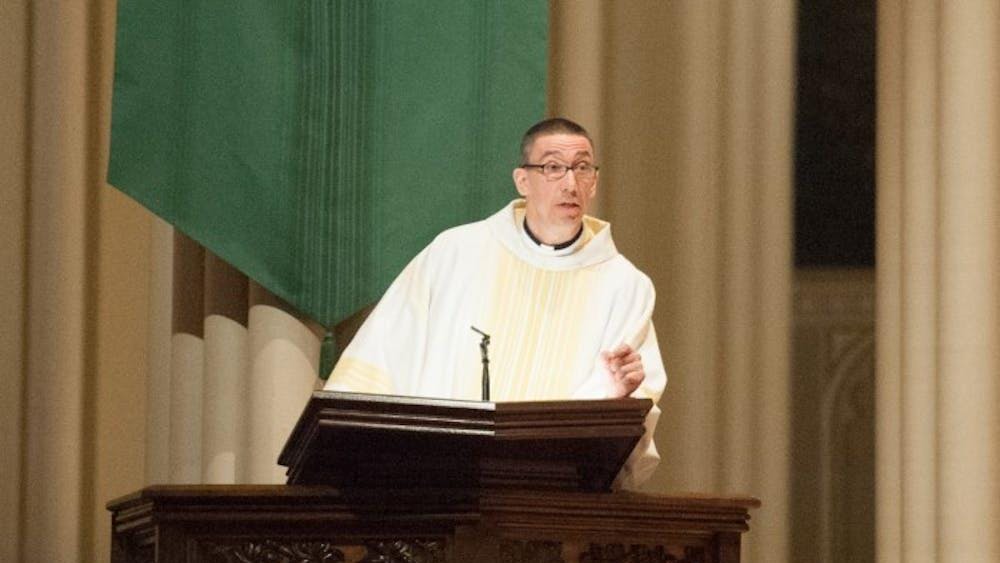Last week, seniors, juniors and sophomores registered for the spring semester; this week, University freshmen will be registering on their own online for the first time. Students wake up early and — in their short time slots — determine their whole semester. As stressful as registering can be, it wasn’t always so easily done from bed.
Up until World War II, students would have to register for classes in person and all of the requests would be written down by hand, University registrar Chuck Hurley said.
“You would get off your horse at the Dome and see Fr. So-and-so, who was the registrar and you would tell him, ‘I want to take arithmetic and blacksmithing,’ and whatever they offered in those days,” he said. “They’d write it down in a ledger book and that’s how it was done.”
For a century, that is how every student would register for their classes; they would not even know if they got into every class they registered for until they arrived on campus for that semester.
“After World War II, as Notre Dame started to grow as an institution, they had to find more and more sophisticated ways of conducting registration,” Hurley said. “It was still a manual process in the 1950s, 1960s, going into the 1970s, but in some ways it mirrored — somewhat — what we do now.”
Each class year would have its day to register, entering South Dining Hall — or, in later years, Stepan Center — where each department would have its own table, winding around the room.
“The department chair would be sitting there and they’d have several stacks of cards,” Hurley said. “One stack of cards might be for History 101 and another might be 100 cards for Calculus. When a person walked in, they’d have to make a decision immediately. You’d walk up to the table, they’d give you a card for the class you needed, then you’d try to sprint over to another table afterwards. You really had to decide what was much important to you.”
Eventually, those cards were switched to punch cards, which were carefully ordered by student and then used to write up class rosters.
“It was very basic at that time,” Hurley said. “It wasn’t stone tablets and chisels, but it was just a step above that.”
Cards were used until the early 1980s, due to an accident with a student.
“In the early 1980s, they were at Stepan Center, still using the same process … and the rush to get into Stepan Center was so heavy that there was a student who was pushed through a plate-glass door on the side of it,” Hurley said. “That happened and they decided they needed to do something better, this was too much.”
From the early 1980s to the mid 1990s, students registered through the phone.
“You’d punch in numbers and every class had a code,” Hurley said. “You had to put in your social security number, and then an entry code, and after that you’d type in a [course registration number] for each class. It would give you a little ‘ding ding’ if you got the class and a different noise if you didn’t get the class.
The telephone registration process, Hurley said, was “slow, but it worked.” The system could only handle 15–20 students at a time; it took over a month for all students to be registered.
Hurley began working for the Office of the Registrar in 1996, after working as a developer for Citibank.
“The internet was just coming about and I built the first registration system online — it was called Irish Link back then,” he said. “Twenty years ago, the computing power was still not great. It was heavy, it was slow, it was still taking a month for all of registration to take place. But at least it was online.”
For the last 10 years, the University has used the Banner system to register students online; NOVO, which Notre Dame went to last year, is an upgrade to that system.
Hurley said that for the past few years, the Office of the Registrar has worked with student government. Many of the changes that came with NOVO started as student government recommendations, including condensing the process more, enhancing the search capability and providing all of the error messages for class restrictions at once.
“I’ve been registrar for five years, and I’ve tried to make [student government] our primary vehicle for student recommendations,” he said. “We need an organized way to take the ideas that come in from students. If students have ideas, go through student government and have them bring those ideas to us.”












